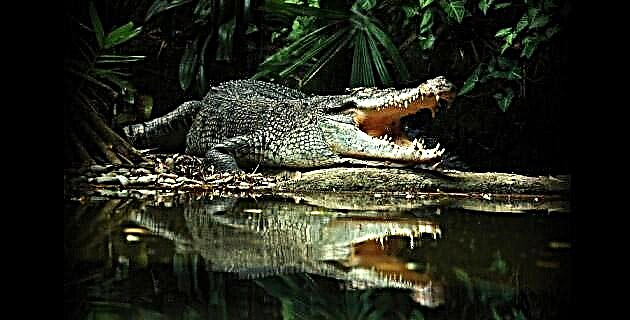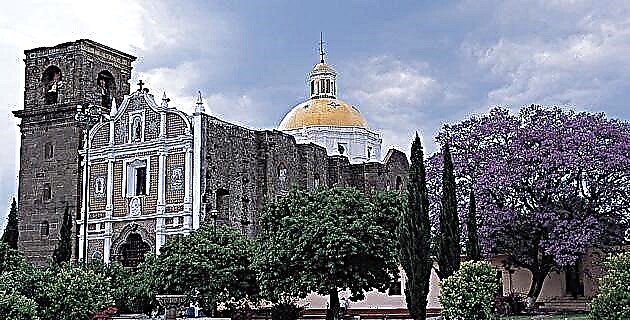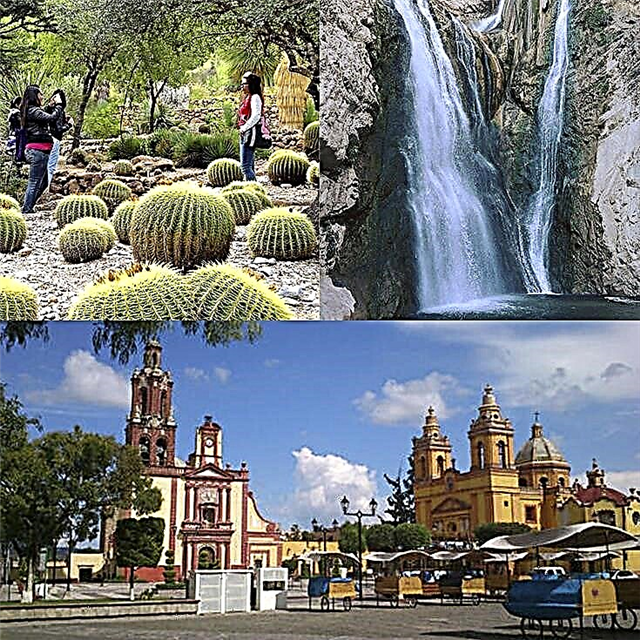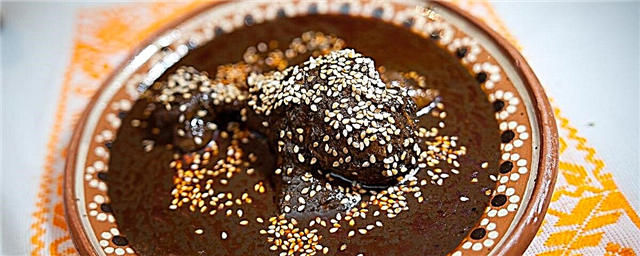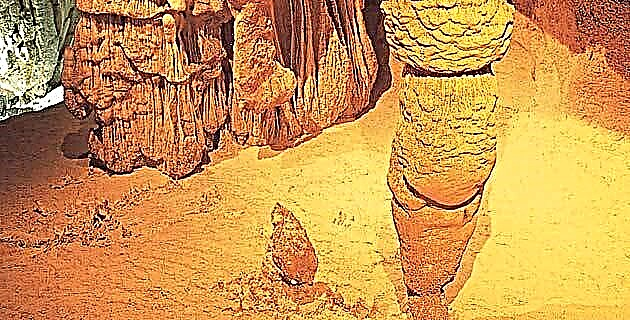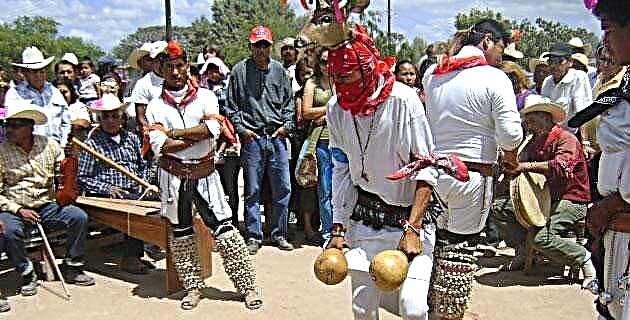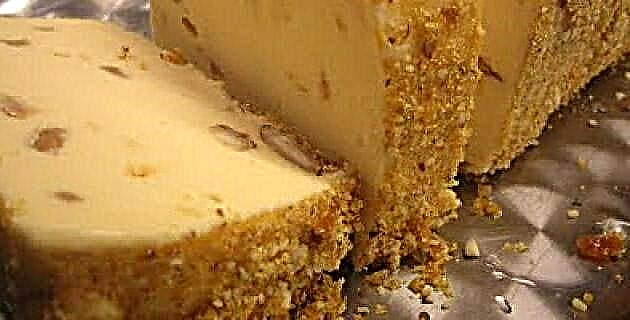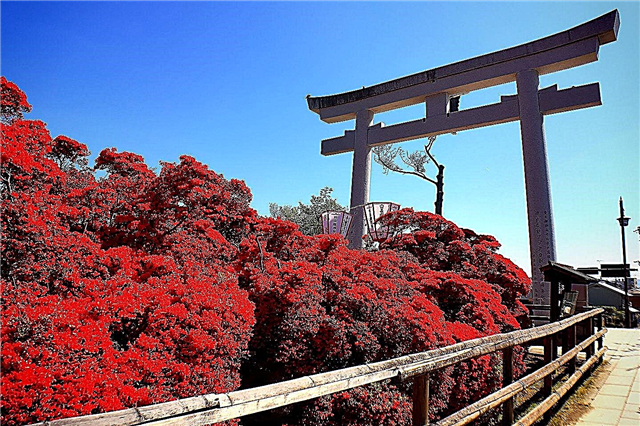Japan is an archipelago divided into four main islands: Hokkaido, Honshu, Kyushu and Shikoku, all with numerous urban areas rich in technology and with a traditional roots focused on their culture.
The third largest economy in the world has many important cities, both for its urbanism and natural eccentricity, as well as for its social, religious and cultural potential.
Each of them has unique qualities that distinguish them from other large metropolises in America or Europe, so I invite you to get to know them.
These are the 81 magnificent cities in Japan that you must visit.
1. Tokyo
 With more than 13 million people, Tokyo, its capital, is an always active city endowed with an enigmatic appearance that mixes the traditional of the Meiji period, with the modern of today.
With more than 13 million people, Tokyo, its capital, is an always active city endowed with an enigmatic appearance that mixes the traditional of the Meiji period, with the modern of today.
Its metropolitan area consists of 23 special neighborhoods that you can travel from end to end and still continue to discover new places with each visit.
2. Kyoto
For more than a thousand years and until more than the middle of the 19th century it was the Japanese capital. It belongs to Honshu Island.
One of the attractions of Kyoto are its Buddhist temples, castles from different Japanese eras, traditional wooden houses and Shinto shrines.
The geishas, a traditional Japanese artist, are always admired by tourists in the Gion district, who can eat kaiseki while watching them, typical food of the place.
Its Philosophers Path is surrounded by cherry and maple trees. The cultural and traditional variety of Kyoto make it a must-see destination.
3. Sapporo
 Its more than 2 million inhabitants make it the fifth largest city in the country.
Its more than 2 million inhabitants make it the fifth largest city in the country.
Although it is known for its beer and the museum dedicated to it, it is its large snowfalls perfect for snowboarding, skiing and other winter sports that have made Sapporo a city to visit.
The beer and snow festivals are held in the Odori Park, in the city center, in summer and winter respectively.
The nighttime attractions take place in restaurants, hotels, bars and venues dedicated to adult entertainment.
4. Osaka
Spectacular port city where modern meets traditional Japanese architecture. Most of the major companies in the country meet there.
Dotonbori is the district with great businesses with luminous signs, where gastronomic specialties and an excellent nightlife are offered.
You cannot be in this city and not visit Osaka Castle, a historical, unmissable, majestic and imposing place.
5. Yokohama
 Splendid, bright and with a very westernized architecture, that is Yokohama, a large city south of Tokyo.
Splendid, bright and with a very westernized architecture, that is Yokohama, a large city south of Tokyo.
The largest Chinatown in Japan is built on it. It has many attractions, including restaurants, parks, shops and a wide cultural spectrum with museums such as maritime, industrial and gastronomic.
Yokohama is a splendid and cosmopolitan city that you cannot miss.
6. Nara
Close to Osaka and Kyoto, Nara was the capital of Japan before Kyoto assumed this political-administrative distinction.
Its contribution to Japanese history is important with temples, works of art and places dating from the 6th century, which further enriches its traditional architecture.
Gardens from the Meiji era and Buddhist temples such as the Todai-ji, which houses a 15-meter Buddha inside, are part of the essence of this captivating city.
7. Naha
 Capital of Okinawa prefecture washed by the East China Sea. It is a vibrant city.
Capital of Okinawa prefecture washed by the East China Sea. It is a vibrant city.
In addition to temples and historical sites for having been the capital of the Ryukyu kingdom until 1879, the greatest exponent of Naha is the Naminoue Shrine, a Shinto shrine.
Mangroves and white sand beaches that make it a paradisiacal city are its main natural attractions.
8. Hiroshima
Although it is sad that it is world remembered for the atomic bomb the United States dropped on it in 1945, which completely destroyed it, Hiroshima is now a fun and modern city.
Its art museum displays paintings by Monet, Van Gogh, and Fujishima. His baseball team, Hiroshima Toyo Carp, plays at the famous Mazda Zoom-Zoom park.
The Itsukushima Shrine with a majestic Tori portal over the sea and the Hiroshima Castle are two other tourist attractions in this beautiful city.
9. Fukuoka
 A great city with a population of over a million and a half inhabitants.
A great city with a population of over a million and a half inhabitants.
The great commercial centers of this city are notorious, among them the Canal City. Its nightlife is ideal with famous street food places called "yatai", which offer a variety of ramen noodle soups.
The spas on Nokonoshima Island are famous and can be accessed via ferries. Be sure to see the 10-meter wooden Buddha at Tocho-ji temple.
10. Kobe
Beautiful city inhabited by more than 1.5 million Japanese. It is an ideal place for the establishment of transnationals in the country, because it has an outlet to the sea.
It has a very fun port in which a peculiar open-air shopping center that has a Ferris wheel stands out. Also add an old cable car that takes you up to Mount Rokko, where you can see Kobe in all its greatness.
The hot springs of Arima Onsen, with more than a thousand years of history, are an essential recreational site in this city.
11. Kagoshima
 City in southern Japan with a temperate climate, temples and museums. Visit its hot springs and the Sakurajima, an active volcano with constant eruptions that, despite being dangerous, is still a tourist attraction.
City in southern Japan with a temperate climate, temples and museums. Visit its hot springs and the Sakurajima, an active volcano with constant eruptions that, despite being dangerous, is still a tourist attraction.
12. Himeji
Mythical place accompanied by myths and stories. One of the most traditional cities in Japan that preserves its original essence.
Among its more than 500 thousand inhabitants is the famous, beautiful and imposing Himeji Castle, one of the three most popular in the country.
13. Kanazawa
It is one of the cities that did not suffer from the bombings of the Second World War, so it preserves an architecture full of history.
Kanazawa has neighborhoods that preserve houses of samurai, warriors of ancient Japan, with preserved structures from the Edo era, between 1603 and 1868. One of them is Nagamachi.
There are also the tea houses where the geishas were presented. One of these in the Higashi Chaya district.
At the Kenroku Garden there is vibrant landscaping with classic streams and ponds, emulating those present in the 17th century.
14. Nagasaki
The second Japanese city to be hit by another atomic bomb dropped by the US on August 9, 1945. It currently has more than 400 thousand inhabitants.
The city had an economic opening very close to the West from the 16th to the 19th century, a notorious influence on its architecture.
The atomic bomb is one of Nagasaki's many majestic museums. Its temples are of various religions such as Christianity, Buddhism and Shintoism.
15. Nagoya
 The fourth largest city in Japan. In it you will find among other museums the Toyota Technology and Industry Museum and the Tukugawa Art Museum, a 12th-century Japanese era.
The fourth largest city in Japan. In it you will find among other museums the Toyota Technology and Industry Museum and the Tukugawa Art Museum, a 12th-century Japanese era.
A large Ferris wheel, the Sky-Boat, restaurants, nightlife and Pachinko lounges with gambling machines are the basis of Nagoya's nightly entertainment.
16. Hakodate
Ci. Go to the north of Japan, which was a port of commerce with the West of the world. Much of its infrastructure is similar to the United States of the 19th and early 20th centuries, an influence that is seen in the Motomachi neighborhood.
Hakodate Asaichi is the meeting point for local merchants offering fresh seafood and sea species, an attraction added to thermal baths such as Yachigashira Onsen at the foot of Mount Hakodate.
You cannot leave Hakodate without first visiting Goryokaku Fort, now full of cherry trees. It is a star-shaped building with a moat around it.
17. Kurashiki
Very picturesque city in Okayama prefecture with a population of about half a million. It is near the Seto Bridge that links the Honshu and Shikoku islands.
Kurashiki has internal pluvial channels with the beautiful Koi fish, supposedly for good luck and with wooden warehouses like those of the 17th century known as, Kura.
18. Nagano
Site of the 1998 Olympic Games with more than 300 thousand inhabitants. Its Zenko-ji temple of Buddhist doctrine erected in the 7th century, is well known throughout Japan.
The mountainous fabric of the area allowed it to host the most important war bunker in the country, during World War II.
19. Okayama
 City of more than 700 thousand inhabitants that contributes a valuable agricultural production of rice, peaches and grapes.
City of more than 700 thousand inhabitants that contributes a valuable agricultural production of rice, peaches and grapes.
Okayama Castle and Koraku-en Garden are two of its main attractions.
If you go to this beautiful city, do not forget to cycle the Kibi Plain route, with a 17-kilometer ride where you will admire the most beautiful temples in the area.
20. Matsumoto
Nagano prefecture city with an average population of 250 thousand inhabitants.
Matsumoto Castle built in the Sengoku era is a grandiose structure considered a national treasure.
It is a beautiful town with mountains, lakes, waterfalls and unforgettable landscapes.
21. Kumamoto
One of the big cities in the south, near Fukuoka. This region has its Kumamon, a black bear winner of the National Pet Contest.
Kumamoto Castle is important for its post-war reconstruction and historical influence, being besieged for 53 days in 1877. For it, the locals eat raw horse meat.
Have fun in its picturesque streets adorned with Kumamon and, if you are risky, try its gastronomy.
22. Akita
Region in the north of Japan with a population density greater than 300 thousand inhabitants.
In addition to tourism with campsites, waterfalls and lakes, Akita is strong in the agricultural, metallurgical and lumber industries.
23. Matsuyama
 Captivating city for its temples, castle and the popular hot springs of volcanic origin known as, onsen.
Captivating city for its temples, castle and the popular hot springs of volcanic origin known as, onsen.
The Dogo Onsen is the most famous hot spring bath that until the middle of the 20th century had an exclusive annex for imperial use.
Matsuyama Castle, among this city of half a million inhabitants, is majestic; dates from the feudal era in Japan.
24. Shizuoka
Its universities and natural attractions with beaches, mountains, waterfalls and at the bottom of the city, the wonderful Mount Fuji, make Shizuoka a fun city of more than 700 thousand inhabitants.
It is a place to see, know and experience.
25. Otsu
Otsu was the capital of Japan in the 7th century, so it contains an abundance of historical material.
Lake Biwa occupies one sixth of its territory and in summer it becomes a beautiful seaside resort where you can go for a ride on a steam boat.
You cannot miss its beautiful and historical temples.
26. Takasaki
It has almost 400 thousand inhabitants, parks and very beautiful temples, one of them, the Shorinzan, from which the Daruma doll arises, the most popular lucky charm in Japan.
Mount Haruma, as well as its lake and hot springs, besides being beautiful, are part of the natural heritage of Takasaki.
27. Fukushima
 Despite suffering a nuclear accident in 2011 as a result of a very severe earthquake and tsunami, Fukushima remains a very attractive city to visit due to its natural beauty.
Despite suffering a nuclear accident in 2011 as a result of a very severe earthquake and tsunami, Fukushima remains a very attractive city to visit due to its natural beauty.
Its Hanamiyama Park offers a splendid walk in spring surrounded by cherry blossoms.
Its outdoor activities are great, especially if you travel with family where you can take it to the Bandai region.
The onsen and hiking are also part of its natural attraction; At Takuya Onsen and Mount Azuma, you can enjoy these activities.
28. Tokushima
City of great natural splendor. It is famous for its Awa Odori festival of traditional dance between August 12 and 15, which attracts more than a million visitors each year.
Do not forget to visit the Strait of Naruto where you will observe the spectacle of eddies formed in its current of water.
29. Okazaki
 City very famous for its fireworks festival on the first Saturday in August. It has very important natural, religious and cultural attractions.
City very famous for its fireworks festival on the first Saturday in August. It has very important natural, religious and cultural attractions.
The climate of Okazaki is very rich to walk among its beautiful natural landscapes. If you visit Japan, an undeniable attraction.
30. Fujisawa
Near Tokyo, Fujisawa is now an environmentally friendly city.
One of the places that you cannot miss is the Enoshima Shrine, an important Shinto temple. Shonan Beach is beautiful and allows surfing among other sea disciplines.
31. Takamatsu
 A beautiful coastal city in Japan with unmatched landscaping.
A beautiful coastal city in Japan with unmatched landscaping.
You can visit Ritsurin Park built during the Edo era. Now it is a sublime and majestic garden among the most important in the world.
The Sanuki Festival plays a fundamental role within the cultural activities of the city. Enjoy it in mid-August.
32. Sendai
Capital city of Miyagi Prefecture, a region with a lot of history.
Within its attraction is everything natural it offers: onsen, mountains, rivers and the Rairaiko Canyon, which allows mountain sports.
The Akiu Onsen and its Tanabata Festival are among the most famous hot springs and festivities in Japan, respectively.
33. Asahikawa
 Second largest city on Hokkaido Island, in northern Japan, popular because its zoo managed to create an ideal environment for the development of animals.
Second largest city on Hokkaido Island, in northern Japan, popular because its zoo managed to create an ideal environment for the development of animals.
Although all its gastronomy is very special, we recommend the soy ramen, Japanese noodles.
In winter, Asahikawa offers great ice sculptures.
34. Hirosaki
North of Japan is an agricultural benchmark that contributes 20% of the national apple production.
Its Hirosaki Castle dating from the seventeenth century is splendid, so much so that it is on the list of the 100 most relevant places to appreciate cherry blossoms.
It is a beautiful region full of nature and cultural depth.
35. Fukuyama
 City between Okayama and Hiroshima. It has historical potential with several sites from the Edo era, including Fukuyama Castle.
City between Okayama and Hiroshima. It has historical potential with several sites from the Edo era, including Fukuyama Castle.
The city has flourished as a fishing port and in it you can learn about the country while walking through some old streets.
Although its beautiful temples invite you to learn more about Japanese culture, Fukuyama is most famous for the production of roses and geta sandals, traditional Japanese footwear.
36. Aomori
It is the capital of the prefecture of the same name and is located in the north of Japan. It enjoys cool weather in the summer.
Heavy snowfall in winter allows skiing at a resort on Mount Hakkoda.
If you visit Aomori between August 2 and 7, you will see the Nebuta Matsuri Festival, with the exhibition of floats with cultural and natural themes.
You can relax and gain the healing properties of a thermal bath at Asamushi Onsen.
37. Kitakyushu
 A vibrant city with a wide industrial field and an architecture rich in history and modernism. It is characterized by its historical sites that survived the Second World War, despite being the target of the atomic bombs.
A vibrant city with a wide industrial field and an architecture rich in history and modernism. It is characterized by its historical sites that survived the Second World War, despite being the target of the atomic bombs.
Its sites to visit are the Kokura Castle, the Kawachi Wisteria Botanical Garden with spectacular wisteria that bloom in April and the Senbutsu Shonyudo Cave.
38. Kawagoe
A city near Saitama and Tokyo that stands out for the history of its streets. It has a special area with merchant houses from the Edo era known as Kashiya Yokocho.
Kawagoe stands out for all its historical wealth, which makes it an ideal place to learn about Japanese traditions.
39. Hamamatsu
 Multicultural city that is believed to have the largest community of Latin Americans in Japan.
Multicultural city that is believed to have the largest community of Latin Americans in Japan.
Its natural appeal is enormous. It has lakes, rivers, beaches, mountains, caves, and waterfalls; sites that encourage hiking and sports in nature.
For more fun visit their theme park, Hamanako Pal Pal.
The Akiha Fire is a festival of the city with fire dance. The Hamamatsu Kite with the display of beautiful kites is also popular.
40. Chiba
A city very close to Tokyo characterized by having the busiest port in the Kanto region.
Although there are several industries near its port, it is a residential area.
Its suspended monorail is very famous, as well as its man-made beach and the 125-meter high harbor tower.
41. Morioka
 Capital city of Iwate, prefecture located to the northeast of Japan 2 hours from Tokyo.
Capital city of Iwate, prefecture located to the northeast of Japan 2 hours from Tokyo.
Despite not having major tourist attractions, it is a very pleasant town. Learn all you can from the ruins of what was once Morioka Castle, home to the Nabu samurai clan that ruled for 700 years.
The gastronomy of Morioka is characterized by a variety of noodle dishes. They stand out for preparing a salty rice cracker known as, nambu senbei.
42. Miyazaki
It is located on the island of Kyushu in southwestern Japan. Its tropical climate makes it attractive for national and international tourists.
It was the popular honeymoon site for Japanese honeymooners before the expansion of commercial flights.
Miyazaki has it all: beaches, parks, sports complexes and a fantastic botanical garden, the Aoshima Subtropical Botanical Garden.
43. Niigata
 The largest coastal city in the Sea of Japan and one of the most populated: more than 800 thousand inhabitants.
The largest coastal city in the Sea of Japan and one of the most populated: more than 800 thousand inhabitants.
They take advantage of rivers and a canal system to grow rice. For this they also have small farms in their limits.
44. Ichihara
Its beaches and festivals such as the Summer Mikoshi are the tourist attractions of this city in the Chiba region, whose coastal area is highly industrialized towards Tokyo Bay.
His soccer team is relatively famous: JEF United Ichihara Chiba.
45. Nagaoka
 Industrialized city with many buildings, including the monumental town hall. Also add small parks and museums that will bring you closer to the Japanese culture.
Industrialized city with many buildings, including the monumental town hall. Also add small parks and museums that will bring you closer to the Japanese culture.
Added to its attractions is the Great Nagaoka Fireworks Festival held in August.
46. Kurume
South of Fukuoka, in southwestern Japan. It is home to the Bridgestone tire factory, a company founded in 1931.
Kurume adds temples and castles to its cultural heritage, as well as festivals and outstanding local crafts such as rantai lacquerware, a method in which layers of lacquer are applied to a woven item.
47. Tottori
 Much of its territory was devastated in the 1943 earthquake. It is a popular city for its large sand dunes on the beach with camel rides. Desert environment used as a movie set.
Much of its territory was devastated in the 1943 earthquake. It is a popular city for its large sand dunes on the beach with camel rides. Desert environment used as a movie set.
More of its tourist attractions are the ruins of Tottori Castle, the celebration of some festivals such as Shan-shan and buildings that keep Japanese history.
48. Shimonoseki
Famous for its fishing for Fugu, a poisonous puffer fish with which delicious dishes are prepared.
At the southwestern tip of Honshu Island, it is considered one of Japan's main fishing ports.
Its tourist attractions focus on historical buildings such as temples, shrines, and battle sites. One of the most visited is the Shinto shrine, dedicated to Emperor Antoku.
49. Matsue
 City west of Honshu Island all surrounded by water. It is located between two lakes, the Shinji and Nakaumi, which communicate with each other by the Ohashi River.
City west of Honshu Island all surrounded by water. It is located between two lakes, the Shinji and Nakaumi, which communicate with each other by the Ohashi River.
Matsue is noted for its castle and one of the oldest and most important Shinto shrines, the Izumo Taisha, whose construction occurred in prehistoric times.
50. Toyama
City that was reborn after the American bombings in 1945. It is on the coastal area of the Sea of Japan surrounded by beautiful mountains.
Its main attraction is the alpine route known as Tateyama Kurobe, a non-rocky path between the mountains whose walls are covered with snow in April. Cable cars, buses and trolleybuses are used, which travel from Toyama to Omachi.
51. Takarazuka
 Takarazuka is crossed in the center by the Muko River and is best known for the theater company, Takarazuka Revue, created by a top businessman in the railway industry in the early 20th century.
Takarazuka is crossed in the center by the Muko River and is best known for the theater company, Takarazuka Revue, created by a top businessman in the railway industry in the early 20th century.
The Takarazuka Grand Theater is the biggest attraction in the city.
52. Odawara
Two of its main attractions are its hot springs and the castle, described as a mountain by the sea with an imposing and incomparable view.
Odawara becomes the gateway to other tourist cities in Japan, such as Hakone and the Izu Peninsula.
53. Kochi
 It is on the Island of Shikoku, one of the least populated of the 4 most important in the country.
It is on the Island of Shikoku, one of the least populated of the 4 most important in the country.
Although it still preserves a monastery that functions in the Chikurinji Temple, an ancient mountain temple from the 8th century, its original castle built in the 18th century is its greatest attraction.
54. Chigasaki
Coastal city near Sagami Bay considered a decisive port in the economy, whose base of productivity is the sea.
It belongs to the Tokyo metropolitan area and stands out for its relaxed beach atmosphere, a characteristic that makes it compared to Hawaii. It is home to the western area of Shonan Beach, one of the most popular among surfers.
Chigasaki is unique due to the particularity that Asian culture gives it.
It is considered a quiet city because many of its inhabitants work in large cities such as Tokyo or Yokohama. Also because many older adults and surfers live.
If the sky is clear, you can see Mount Fuji from the Chigasaki area of Shonan Beach.
55. Myth
 City just over an hour from Tokyo, towards the northwest.
City just over an hour from Tokyo, towards the northwest.
One of its main tourist attractions is the Kairakuen Garden, one of the most popular places in Japan for the flowering of plum trees between the end of February and the beginning of March, a fantastic natural phenomenon. There are about 3,000 trees of about 100 different varieties.
The Plum Blossom Festival is the sign of the arrival of spring. Plum blossoming occurs when winter is still prevalent in other areas.
56. Nishinomiya
City between Kobe and Osaka, near the Gulf of the latter. These are connected through a train whose journey takes about 15 minutes.
The natural environment is exceptional and the culture is very lively, elements that attract many tourists.
Another great attraction is the Koshien Stadium where the Hanshin Tigers play, whose fans are among the liveliest and most firm in their rivalry with the Tokyo Giants.
Although Nishinomiya is characterized by having expensive residential areas, it is still very attractive to live in due to its diversity of parks.
57. Numazu
 Small city at the northern end of the Izu Peninsula, near the west side of Tokyo, northeast of Suruga Bay. Its great attractions are the beaches and onsen centers.
Small city at the northern end of the Izu Peninsula, near the west side of Tokyo, northeast of Suruga Bay. Its great attractions are the beaches and onsen centers.
The beautiful sunsets from Senbon Beach allow for a beautiful view of Mount Fuji, as long as the sky is clear.
The portal against tsunami offers you varied routes and the imposing height gives you beautiful panoramic views of the environment.
58. Wakayama
One of the wonders of Wakayama, a city in the Kansai region, is its musical highway, one of the 3 that all Japan has, which plays a Japanese ballad when passing at the correct speed. Listen here to the result of this technological marvel.
Its metals industry has resurfaced after the fall of the last decade of the 1990s, due to the great development of the steel industry. Almost half of the population of Wakayama prefecture is concentrated there.
In the central area of the city is the Wakayama Castle, which together with its marina, are the most visited areas of the metropolis.
Its most famous dish is umeboshi, a plum-based pickle.
59. Kawaguchi
 Considered a suburban city of Greater Tokyo with all the attractions typical of the Japanese suburbs: bowling rooms and restaurants with a family atmosphere.
Considered a suburban city of Greater Tokyo with all the attractions typical of the Japanese suburbs: bowling rooms and restaurants with a family atmosphere.
It is located in the south of the Saitama region very close to the Arakawa River, which is also bordering Tokyo, so many in Kawaguchi work or play in the capital.
60. Kashiwa
Very close to Tokyo, in Chiba prefecture. Despite its residents being very regional and identified with the area, its atmosphere is compared to that of a Tokyo neighborhood.
The city center is mainly distributed in the Takashimaya department store and its train station. It has one of the 5 campuses of the University of Tokyo.
61. Iwaki
 City in Fukushima prefecture, very close to the Pacific coast.
City in Fukushima prefecture, very close to the Pacific coast.
Visit the Hawaiians Spa Resort, one of the survivors of the economic debacle of the 1990s, which in addition to a huge pool is famous for its hula hula shows.
After overcoming the damage caused by the Tohoku earthquake and tsunami in 2011, it reopened in 2012.
Iwaki is one of the towns that was closest to the Fukushima Daiichi nuclear disaster.
62. Sasebo
Sasebo is the second largest city on Kyushu Island, in Nagasaki. It works as a port very close to China and Korea in which fishing, naval and metallurgical activities stand out.
There are the naval bases of Japan and the United States, so it has a very busy nightlife with restaurants that offer their menus in English.
It is a town known for its festivals and onsen; undoubtedly, an indisputable attraction for the arrival of tourists, who also stroll through its impressive bay of several small islands.
Add to the Huis Ten Bosch, a Dutch theme park with windmills, tulips and canals.
63. Matsudo
 Considered the third largest city in Chiba, Matsudo, east of Tokyo, is one of its great "bedroom" cities.
Considered the third largest city in Chiba, Matsudo, east of Tokyo, is one of its great "bedroom" cities.
It grew in population due to the economic explosion in Japan that allowed the construction of buildings, until it became one of the great suburbs of Tokyo.
64. Maebashi
It is the capital city of Gunma Prefecture, an hour and a half from northwest Tokyo by train. The greenery of nature and the greatness of its rivers predominate, whose water is pure, according to the testimonies of locals.
It is considered one of the main cities located in the interior of Japan.
65. Suita
 One of the most beautiful cities in Osaka, north of this prefecture. It is part of its metropolitan area.
One of the most beautiful cities in Osaka, north of this prefecture. It is part of its metropolitan area.
The National Museum of Ethnology is joined as tourist centers by its parks, universities and museums.
66. Utsunomiya
Capital of Tochigi, to the north and two hours by train from Tokyo.
Utsunomiya is a highly industrialized city that has the Kiyohara Industrial Park and companies linked to Canon and Honda.
Technology is one of its attractions, as are its urban shows and exclusive jazz bars.
The Temple of Oyaji surrounded by impressive rock formations and large cliffs, is visited annually by thousands of tourists.
67. Kure
 A city south of Hiroshima prefecture considered a port and shipbuilding center, which participated in the Second World War with the bombardment of many submarines.
A city south of Hiroshima prefecture considered a port and shipbuilding center, which participated in the Second World War with the bombardment of many submarines.
Thanks to this nature, Kure is the cradle of naval parks and museums that keep the naval construction and history of Japan. One of the most popular is the JMSDF Kure Museum.
68. Toyohashi
It is considered the most important port in the commercialization of vehicles such as the Toyota, Mitsubishi, Ford, Audi, Porsche brands, among others produced in Japan.
Toyohashi is a town that is gaining more and more urban features due to the proliferation of shops, entertainment venues, restaurants and a relative nightlife.
Its historic buildings such as the Urigo Ruins and Yoshida Castle, plus the surfing beaches, add to its natural appeal.
The festivals cannot be missed and Toyohashi's is one of the most popular.
69. Akashi
 From its beaches you can see huge and unsurpassed views of the Akashi Kaikyo Bridge, thanks to its location close to Kobe.
From its beaches you can see huge and unsurpassed views of the Akashi Kaikyo Bridge, thanks to its location close to Kobe.
It is part of the Keihanshin metropolitan region because it is located in the extreme west of the Kobe - Osaka - Kyoto area.
70. Funabashi
It is located in the western area of Chiba, so it is also part of Greater Tokyo. It is considered the second city with the most inhabitants of this locality after Chiba prefecture.
Among its variety of urban attractions is Lalaport Tokyo Bay, a shopping center with more than 500 shopping stores, and the Dutch theme park, Andersen Park.
Be sure to visit its temples rich in Japanese history and culture.
71. Yokosuka
 Its most identifiable trait in the world is being home to the Nissan automobile company and the Yokosuka Naval Base, a spectacular base in the United States.
Its most identifiable trait in the world is being home to the Nissan automobile company and the Yokosuka Naval Base, a spectacular base in the United States.
Yokosuka also stands out for being the refuge of the battleship Mikasa, a ship rescued from the deep sea. It is now a museum open to the public.
This coastal city has a nightlife characterized by its rock, punk and country music spots.
72. Kawasaki
The city of Kawasaki belongs to the metropolitan area of Tokyo, between the capital and Yokohama, at the mouth of the Tama River.
It is considered a suburban place with attractive neighborhoods that enjoy landscapes mixed between industry and peripheral settlements.
One of its biggest seductive events for foreigners are the spring festivals such as the Kanamara Matsuri, a festival of Shinto origin that venerates the penis and fertility.
73. Takatsuki
 City between Osaka and Kyoto with relatively dense population. It stands out for its university campuses.
City between Osaka and Kyoto with relatively dense population. It stands out for its university campuses.
Although it does not have major tourist attractions, it is very close to beaches for surfing and areas for climbing or skiing.
74. Saitama
It is the capital city of Saitama Prefecture (Kanto region) and the most populated in this area. It is very close to Tokyo, half an hour away by train.
Saitama is characterized by having a developed suburban life that can be easily appreciated.
75. Hiratsuka
 It is part of Greater Tokyo and is in Kanagawa Prefecture. Its coastal location places it near Sagami Bay.
It is part of Greater Tokyo and is in Kanagawa Prefecture. Its coastal location places it near Sagami Bay.
It is an area that serves as a port with an economic base in maritime activities. It is considered a "bedroom" city of Tokyo and Yokohama.
Among its attractions we find a large stretch of beach that belongs to Shonan Beach. The Great Festival of Tanabata, better known as the festival of the stars, is celebrated in July.
76. Joetsu
In Niigata prefecture, Mount Hotaka is very close.
El pequeño Castillo de Takada es un espectáculo nocturno con la iluminación de los árboles que le rodean, en la época en que florecen los cerezos. Miles de personas lo ven cada año.
Otro sitio de interés histórico en Joetsu es el Castillo Kasugayama. Se suman sus resorts y museos.
77. Ichinomiya
 Es una ciudad muy cercana a Nagoya. Su Río Gojo está bordeado por árboles de cerezo. El santuario sintoísta Masumida data del siglo VII y tiene un valor histórico y cultural importante que no puedes perderte.
Es una ciudad muy cercana a Nagoya. Su Río Gojo está bordeado por árboles de cerezo. El santuario sintoísta Masumida data del siglo VII y tiene un valor histórico y cultural importante que no puedes perderte.
78. Higashiosaka
Es una ciudad vecina de Osaka con varios sitios para las actividades familiares, el esparcimiento y la recreación en la naturaleza. Suma además lugares para el crecimiento espiritual y cultural.
79. Koshigaya
 Es una localidad cercana a Saitama con muchas bondades naturales como parques.
Es una localidad cercana a Saitama con muchas bondades naturales como parques.
80. Amagasaki
Aunque es una zona bastante industrializada con un aire retro de los años 70 y 80 de Japón, al estar entre Osoka y Kobe, Amagasaki es vista como un suburbio.
81. Yokkaichi
 Si eres amante de la fotografía que enfatiza la cultura industrial, Yokkaichi este para ti.
Si eres amante de la fotografía que enfatiza la cultura industrial, Yokkaichi este para ti.
Muchas de las grandes empresas producen en esta ciudad desde textiles, partes de computadora, automóviles y hasta los tés que beben millones de personas.
Aquí las tienes, 81 ciudades en Japón que debes visitar al aterrizar en la tierra de Godzilla. Solo planifica tu viaje y verás que será muy fácil trasladarte de una metrópolis a otra, con lo que conocerás de cerca una variada y enriquecedora cultura.
Comparte este artículo en las redes sociales para que tus amigos y seguidores también conozcan las 81 urbes más fantásticas de Japón.


